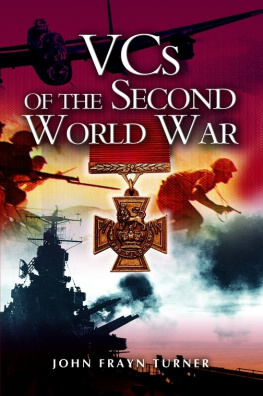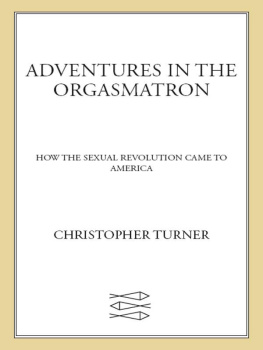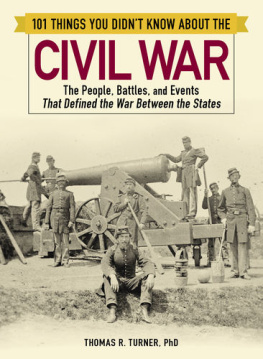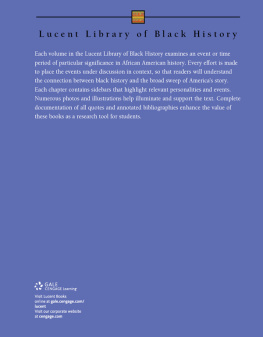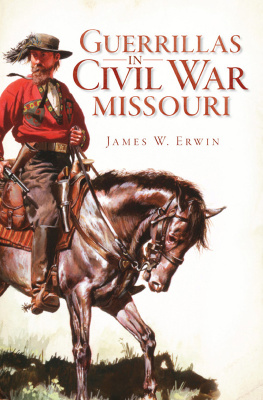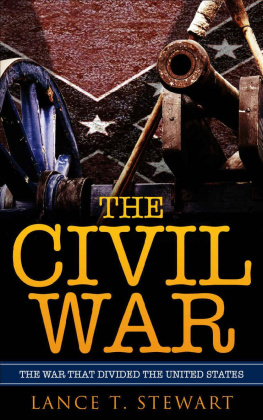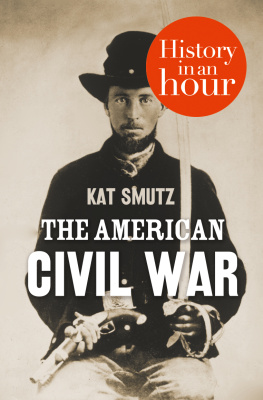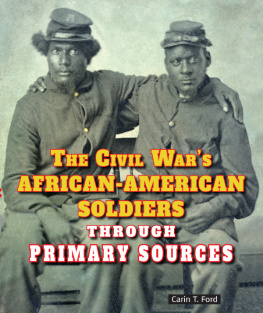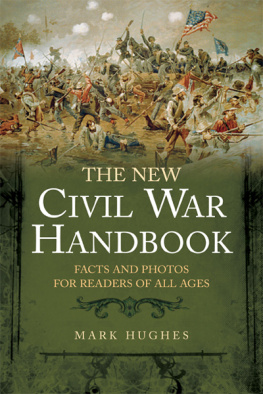THINGS
YOU DIDNT
KNOW ABOUT THE
CIVIL WAR
Places, Battles, GeneralsEssential Facts
about the War that Divided America
THOMAS TURNER, PH.D.

Adams Media
Avon, Massachusetts
Copyright 2007, F+W Media, Inc.
All rights reserved. This book, or parts thereof, may not be reproduced in any form without permission from the publisher; exceptions are made for brief excerpts used in published reviews.
Published by Adams Media, a division of F+W Media, Inc.
57 Littlefield Street, Avon, MA 02322
www.adamsmedia.com.
Contains material adopted and abridged from The Everything Civil War Book, by Donald Vaughan,
Copyright 2000, F+W Media, Inc.
ISBN 10: 1-59869-320-4
ISBN 13: 978-1-59869-320-1
eISBN: 978-1-44051-668-9
Printed in the United States of America.
10 9 8 7 6 5 4 3 2 1
Library of Congress Cataloging-in-Publication Data
Turner, Thomas Reed
101 things you didnt know about the Civil War /
Thomas R. Turner.
p. cm.
ISBN-13: 978-1-59869-320-1 (pbk.)
ISBN-10: 1-59869-320-4 (pbk.)
1. United StatesHistoryCivil War, 18611865Miscellanea.
I. Title. II. Title: One hundred and one things you didnt know
about the Civil War. III. Title: One hundred one things
you didnt know about the Civil War.
E468.9.T87 2007
973.7dc22 2007002719
This publication is designed to provide accurate and authoritative information with regard to the subject matter covered. It is sold with the understanding that the publisher is not engaged in rendering legal, accounting, or other professional advice. If legal advice or other expert assistance is required, the services of a competent professional person should be sought.
From a Declaration of Principles jointly adopted by a Committee of the
American Bar Association and a Committee of Publishers and Associations
Many of the designations used by manufacturers and sellers to distinguish their products are claimed as trademarks. Where those designations appear in this book and Adams Media was aware of a trademark claim, the designations have been printed with initial capital letters.
Interior photographs American Spirit Images
This book is available at quantity discounts for bulk purchases.
For information, please call 1-800-289-0963.
CONTENTS
PART ONE
The Coming of the War
PART TWO
The Engagements of Wartime
PART THREE
The Weapons of War
PART FOUR
The Horrors of War
PART FIVE
The Homefront
PART SIX
The End of the Conflict,
Reconstruction, and the Wars Legacy
INTRODUCTION
THE AMERICAN CIVIL WAR has often been called the American Iliad evoking parallels with the Trojan War. Just as that ancient contest became a defining moment for Greek history, the Civil War remains an epic moment in the American story. Some of the most revered names in our history emerged from the conflict: Grant, Sherman, Lee, Jackson, and Lincoln. Millions of Americans still visit the Gettysburg battlefield, Lincolns Home in Springfield, Illinois, or the Lincoln Memorial. Almost a century and a half after its conclusion, the wars hold on the public imagination shows no signs of abating.
Perhaps part of the fascination comes from the fundamental changes that the war brought to society. While the conflict is partially the story of high-ranking statesmen and generals, almost no citizen remained untouched and not just the soldiers who fought and died. Women, for example, assumed new roles as their husbands went off to war and they were forced to run the farms and plantations or to work in factories. New and more destructive weapons were introduced including a Confederate submarine, the CSS Hunley, which sank the Union warship Housatonic.
Above all, however, the war allowed Americans to finally come to grips with the issue of slavery. Lincolns immortal address at Gettysburg framed the purpose of the war with his references to the Declaration of Independences avowal that all men are created equal and his hope that government of the people, by the people, and for the people, shall not perish from the earth. Nearly a century and a half later Americans still struggle to make Lincolns dream a reality.
However, Americans should resist the temptation to dwell only on the glorious aspects of the Civil War. The deaths of 622,000 soldiers provide a stark reminder of the terrible price that the nation paid to keep the Union intact and to eradicate slavery.
PART ONE
THE COMING OF THE WAR

TO UNDERSTAND WHY THE CIVIL WAR OCCURRED, it is important to know what the United States was like in the mid-1800s. Unlike the 50 states we have today, the United States in the years preceding the Civil War was more like two separate countries living together as one. The North and the South were more disparate than they were alike, and these differences became increasingly vivid until, like a bickering married couple on the verge of divorce, they simply couldnt bear to live together anymore.
ITS NOT JUST
ABOUT SLAVERY
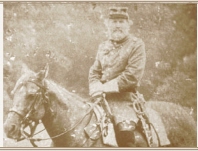
ITS IMPOSSIBLE TO NARROW the cause of the Civil War to a single issue or act. Most people today, if asked, would probably say slavery. But while its true that slavery was one of the most important contributing factors to the conflict, it was not the singular cause. In truth, the war was the result of myriad cultural and political issues that perniciously set the North and the South against each other for decades before the first shots of the war were fired.
A short 10 years before the war began, the vast majority of Americans in both the North and the South lived in rural areas rather than cities. Agriculture remained the biggest contributor to the nations economy, and in this way, the two regions were very much alike. But between 1850 and 1860, the nations burgeoning citiesparticularly in the Northreceived a massive influx of immigrants. The number of farm dwellers increased by 25 percent during this period, while urban populations rose by a remarkable 75 percent. New York City, for example, reached a population of nearly 800,000 by 1860, making it the greatest city in the Western hemisphere.
As a result of this influx, the nations population increased by 35 percent to nearly 31 million. But the South didnt benefit from this population spurt. By 1850, only a third of Americans lived in the South, compared to half at the beginning of the century. And of the nations 10 largest cities, only New Orleans was located in the lower Southern region.
Indeed, the years before the wars onset saw some dramatic and fundamental changes in the nations face. The North quickly took advantage of the amazing new products resulting from the industrial revolution, such as Cyrus McCormicks mechanical reaper, and great factories sprang up almost overnight as huge deposits of iron, coal, copper, and other important manufacturing basics were discovered and made available. It would be this industrial power, this ability to produce weapons and other goods, that would give the North a decided edge as the Civil War progressed.
The economy of the South, in comparison, remained based primarily on agriculture, with England and the Northern states being its biggest customers. (In 1852, a mere tenth of the goods manufactured in America came from Southern factories and mills.) Cotton, in particular, was a huge cash crop that brought large amounts of money to the region, though tobacco, rice, indigo, and other products were also widely grown. By 1860, the South was producing nearly three-fourths of the raw cotton used throughout the worldan estimated 1 billion pounds a year. But because the South lacked the manufacturing capability of the North, the region was forced to buy back the goods created from the products it grew, placing it at an economic disadvantage that angered many Southerners. This inequity played a large role in widening the division between the North and the South.
Next page

